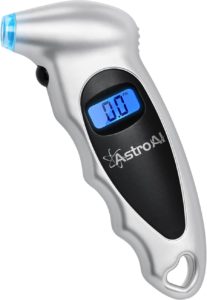The Audi A6 tire pressure monitoring system (TPMS) is a feature that helps drivers to maintain the correct tire pressure in their vehicle. The indirect tire pressure monitoring system (TPMS) in the Audi A6 takes a distinctive approach to keeping an eye on tire pressure. Instead of using individual sensors inside each tire, it uses the anti-lock braking system (ABS) to monitor tire pressure changes. By analyzing the rotational speeds of each wheel, the system can identify discrepancies that may signify a change in tire pressure. When the TPMS detects a potential pressure issue it triggers a warning light on the dashboard alerting the driver to inspect the tires and adjust the pressure accordingly. This innovative method allows for a seamless integration of tire pressure monitoring without the need for additional hardware or battery-powered sensors. This can simplify maintenance and ensure optimal tire performance for a safe and comfortable driving experience.
How Does the Audi A6 TPMS Work?
Utilizes ABS: The Audi A6 indirect TPMS leverages the vehicle’s anti-lock braking system (ABS) to monitor tire pressure, instead of using dedicated sensors in each tire.
Wheel Rotation Speeds: The system analyzes differences in the rotational speeds of each wheel to detect variations in tire pressure.
Warning Light Activation: When the indirect TPMS detects a potential pressure issue, it triggers a warning light on the dashboard to alert the driver.
Seamless Integration: Indirect TPMS requires no additional hardware or battery-powered sensors, making it easier to maintain compared to a direct TPMS system.
TPMS Malfunction Indicator: If the TPMS detects a malfunction within the system a separate warning light will illuminate on the dashboard, indicating the need for system diagnostics and repairs.
Audi A6 Tire Pressure Light Reset Procedure
Be sure to fill your tires to the correct PSI prior to following this procedure.
Turn the ignition key to the “On” position or have the vehicle running.
Select Home and then Vehicle
Select Settings & Service
Select Tire Pressure Monitor
Select “Store Tire Pressure” and then “Yes, Store Now”
Car will confirm with “The current tire pressure has been stored”
Audi says to drive the vehicle for at least 20 minutes at speeds above 12 mph to allow the system to recalibrate.
When to Reset Audi A6 Tire Pressure Light
Tire Rotation: Reset the indirect TPMS after rotating the tires to ensure accurate monitoring of the new tire positions.
Tire Replacement: When replacing one or more tires on the vehicle, it’s essential to reset the TPMS to maintain accurate pressure monitoring.
Seasonal Tire Change: When switching between summer and winter tires, reset the indirect TPMS to account for the different tire types.
Tire Pressure Adjustment: If tire pressure has been adjusted due to changes in load or driving conditions, resetting the TPMS can help maintain accurate monitoring.
TPMS Malfunction Indicator: If the TPMS malfunction indicator light illuminates on the dashboard, resetting the system may resolve the issue after diagnosing and repairing any detected problems.
After Inflation: If the tire pressure light comes on due to low pressure and the tires have been inflated to the recommended level, reset the TPMS to clear the warning.
Wheel Alignment or Balancing: After performing wheel alignment or balancing services, reset the TPMS to ensure accurate tire pressure monitoring.
ABS Sensor Replacement: Since the indirect TPMS relies on data from the ABS, it’s important to reset the system after replacing an ABS or wheel speed sensor to maintain accurate pressure monitoring.
TPMS Software Update: If the vehicle’s TPMS software has been updated, reset the system to ensure proper functionality with the latest software version.
Vehicle Battery Replacement: After replacing the vehicle’s battery, (or after jump starting a dead battery) resetting the TPMS may be necessary to re-establish proper communication between the system and the vehicle’s onboard computer.
Common Causes for Tire Pressure Light to Turn On:
Low Tire Pressure: The most common cause for the indirect tire pressure light to turn on is low tire pressure, often resulting from natural pressure loss over time or temperature fluctuations.
Tire Puncture or Leak: A puncture or leak caused by a sharp object or road debris can lead to a rapid loss of tire pressure, triggering the warning light in an indirect TPMS.
Mismatched Tire Sizes: If the tires on the vehicle have different sizes or are not of the same type, it can cause discrepancies in wheel rotation speeds, leading the indirect TPMS to falsely detect a pressure issue.
Uneven Tire Wear: Tires with uneven wear can have different rolling diameters, causing variations in wheel speed that may trigger the indirect tire pressure light.
Tire Rotation or Replacement: If the TPMS has not been reset after tire rotation or replacement, it may not accurately detect tire pressure changes, leading to a false warning.
Wheel Alignment Issues: Poor wheel alignment can cause variations in tire rotation speeds, which may be misinterpreted by the indirect TPMS as a pressure issue.
Malfunctioning ABS Sensor: Since the indirect TPMS relies on data from the ABS, a faulty ABS sensor can cause inaccurate tire pressure readings and trigger the warning light.
TPMS Software Issues: Problems with the TPMS software or firmware can lead to false warnings, causing the tire pressure light to turn on even when tire pressures are within the recommended range.
Tire Pressure Variation: If the tire pressure in one tire differs significantly from the others, it may cause the indirect TPMS to detect an issue and trigger the warning light.
What Happens When Tires are Underinflated?
Decreased Fuel Efficiency: Underinflated tires create more rolling resistance, leading to higher fuel consumption and increased emissions.
Reduced Handling and Stability: Tires with low pressure can negatively impact vehicle handling and stability, making it more difficult to control the car, especially during sudden maneuvers.
Increased Tire Wear: Underinflated tires cause uneven and accelerated tread wear, resulting in the need for more frequent tire replacements.
Overheating: Low tire pressure can cause the tire to overheat due to increased friction between the tire and the road surface, potentially leading to tire failure or blowouts.
Longer Braking Distance: Underinflated tires can increase braking distances, affecting the vehicle’s ability to stop effectively in emergency situations.
Reduced Load Carrying Capacity: When tires are underinflated, the vehicle’s load carrying capacity is compromised, potentially causing damage to the suspension and other components.
Decreased Tire Life: Tires that are consistently underinflated will have a shorter lifespan, increasing the overall cost of tire maintenance.
Increased Risk of Hydroplaning: Underinflated tires are more prone to hydroplaning on wet surfaces, as they have a reduced ability to channel water away from the contact patch.
Compromised Ride Comfort: Low tire pressure can result in a less comfortable ride due to increased road noise and vibration.
Greater Environmental Impact: Increased fuel consumption and emissions from underinflated tires contribute to air pollution and climate change.



